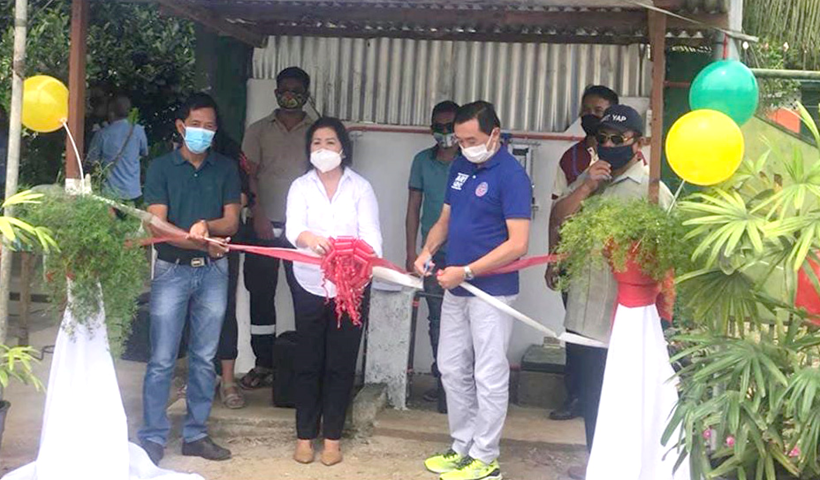
NOTE: This story was first published in The Bohol Chronicle’s Sunday print edition.
The town of Trinidad holds the record of being the first local government unit to launch a barangay water project under the Accessible, Reliable and Timely (ART) Water for All program of the current provincial administration.
Gov. Art Yap on June 25 led the ribbon-cutting ceremony for the Salintubig water system rehabilitation project in barangay Guinobatan, Trinidad, the first coin-assisted water system launched in his administration under the ART Water for All program.
With the governor during the inauguration of the first water project in Trinidad were Trinidad Mayor Judith Cajes, Vice-Mayor Manuel Garcia, former Second District congressman Roberto Cajes, Bohol Environment Management Office (BEMO) Head Tata Ganub, Guinobatan Barangay Captain Esteban Ibaoc and the 19 other barangay captains of Trinidad.
Yap, however, said that the coin-assisted water system projects are just short-term solutions to meet the need for drinking water of households.
For the long-term solution, the provincial government will put four reservoir systems in different parts of Bohol to serve northern Bohol, southeastern Bohol, central Bohol and northeastern Bohol.
In the coin-assisted system, one will just have to insert P5 in the machine and the water that will flow can fill up two containers. One container has a capacity of 20 liters of water.
“It’s only the start since the rest of the barangays will be next in line. In Trinidad, seven barangays have gone ahead in line in the ART Water for All program- -Guinobatan, La union, Kinan-oan, Tagum Norte, Sto. Tomas, Hinlayagan Ilaud and Banlasan,” Yap said.
The town of President Carlos P. Garcia has existing coin-assisted water systems and Mayor Fernando Estavilla showed the governor the one in barangay Aguining when the latter visited the island town on Tuesday last week, but the LGU requested for additional coin-assisted water system projects to be installed in other areas of his town.
Yap explained that the coin-assisted system has an advantage in ensuring collection of payments from consumers, since the budget for the water projects will not come from the regular budget of the provincial government or from the municipalities.
It will come from a loan with Land Bank of the Philippines and Development Bank of the Philippines where the provincial government has credit lines.
He further explained that because the provincial government has mandatory expenditures and to wait for the water projects to be included in the regular budget of the provincial government or the municipalities, it would take time for the water projects to be realized.
It is also futile to expect private companies to invest on waterworks projects in the far-flung barangays, as they tend to be more interested in investing in Panglao, Dauis and Tagbilaran which are already progressive and return of investment is assured in a shorter period of time.
“If the private sector will not come to invest in Bohol, the provincial government will have to do it by itself together with other possible partners,” Yap said.
The governor noted that “if we are going to evaluate the total water resources of Bohol, the surface water resource (those that need no drilling)- -the open water sources such as streams and rivers, Bohol has overcapacity in terms of water resources”.
If properly developed, 20 percent of these water sources can be utilized.
In his visits to the barangays during the campaign period for the 2019 elections, Yap noticed that the common problem in far-flung areas is water supply.
He said he even thought the third district had the worst water problem, but when he got the data from the PPDO, he realized almost if not all the barangays in the second district have problems regarding water.
Out of the 1,109 barangays there are around 600 barangays that have no water or if there is water in the area, the supply is at critical level.
Moreover, there are around 300 barangays that have difficulty in water supply.
So, he decided then that if he would be given a chance to become governor of Bohol, water would be a major project in his administration.
Now that he is governor, he said he is willing to cancel some of his projects and appropriations but he is not willing to cancel water projects.
The governor also said that the people may still survive, though with less convenience, without roads; but they cannot make it nor be able to move forward without water.
Yap pointed out that water is significant not only in the usual daily routine but also in the fight against Covid- -both in the agenda on prevention and food security.
He said water is necessary to maintain hygiene and sanitation, and for the cultivation of rice, crops, fruits and vegetables.
The water projects will also be a revenue-generating venture for the barangays and the municipalities.
